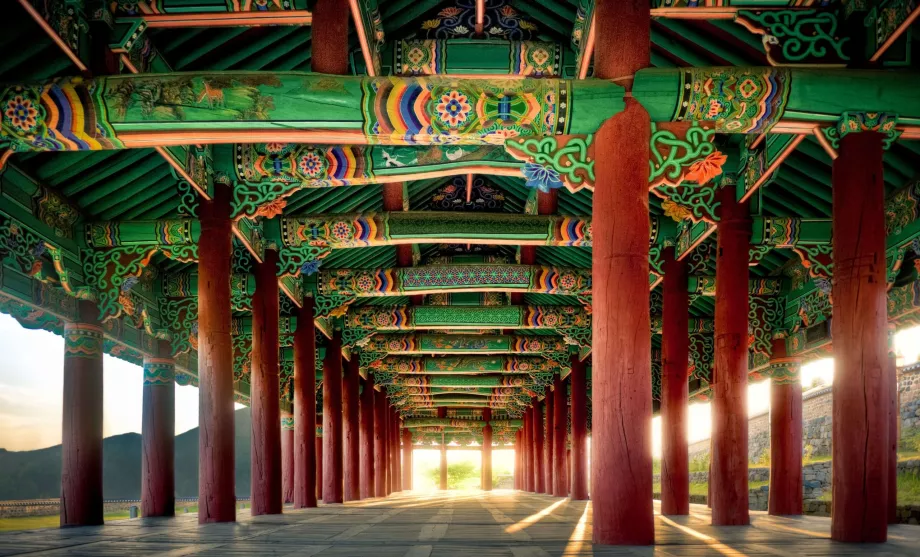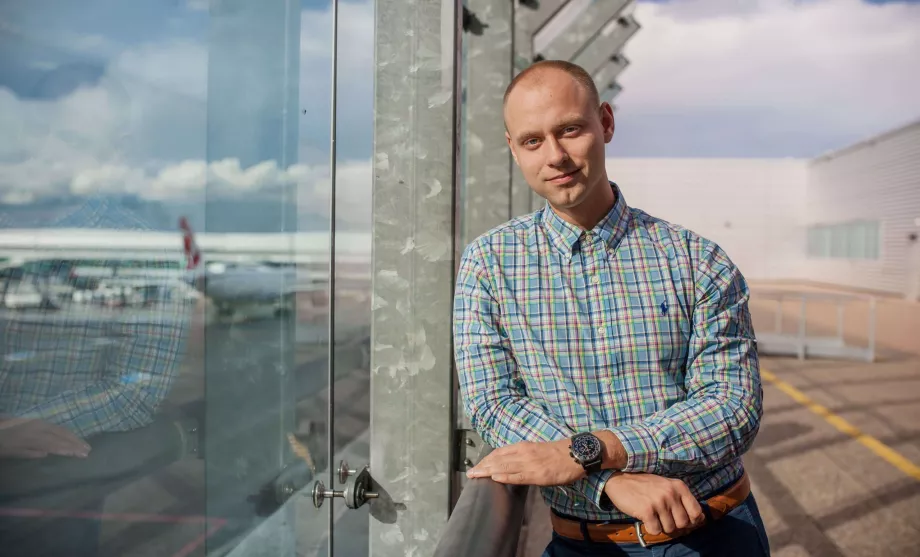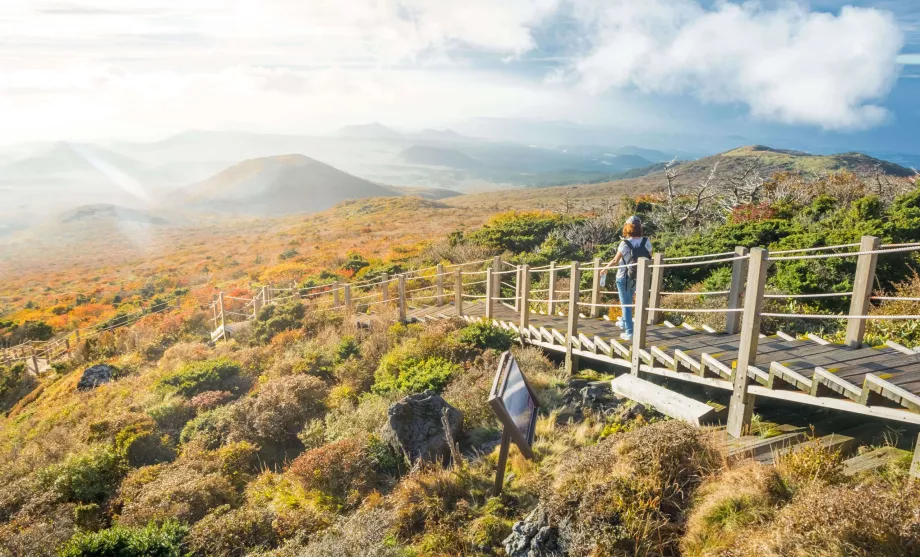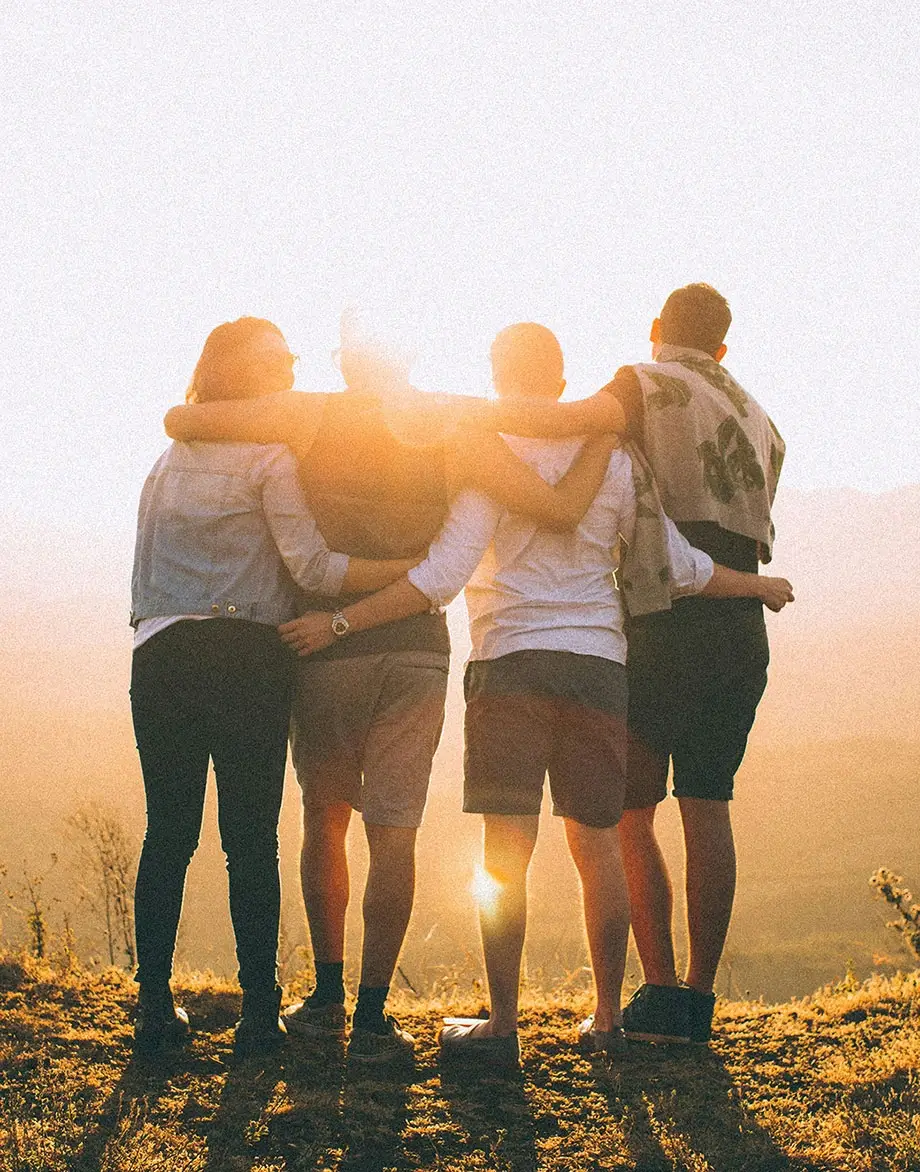What to do in South Korea

Treks
Koreans love trekking, especially on weekends. If you go on a trek in the summer, chances are you'll be surrounded by enthusiastic photographers of all ages. The mountain peaks range in altitude from a few hundred meters to well over a thousand. The highest peak (the extinct Halassan volcano) can be climbed. One of the most popular destinations, even for Koreans themselves, is Mudeungsan Natinal Park, near the city of Gwangju on the southern half of the island. It's easy to get here from the city by bus (#54) or by taxi, which costs $5 (2017).
Hallasan Park
Hallasan on Jeju Island is a UNESCO World Heritage Site due to its interesting flora and fauna. The park includes South Korea's highest mountain, which can be climbed. You can do it comfortably in 1 day. The weather on the island varies a lot, so be sure you are well equipped. Depending on your fitness level, you can choose how far you walk in the park. Hallasan offers 7 possible trail options: the Eoseungsaengak (1.3 km) Seokgulam (1.5 km), Yeongsil (5.8 km), Eorimok (6.8 km), Donnaeko (7 km) Gwaneumsa (8.7 km) and Seongpanak (9.6 km). You can also camp in the park for a fee.
Anmiongogage Hill near Changwon Town
This 9-km-long hill extends from Taebaek - dong in Jinhae to Anmin - dong in Changwon, on the southern part of the main island. From the top you can see Jinhaema harbour, Ungsan mountain, Sirubong or Cheonjabong. You can hike or drive or cycle here.
Diving
Diving is not one of the most popular activities. Therefore, if you are new to diving and would like to give it a try here, you probably won't be able to get by with lessons in English. Many centres can be found on the south and west coasts. Jeju Island (Chedzu) offers divers a unique viewing experience with its unique mix of warm and cold water species.
Beaches
Korea isn't a place many of us go to for seaside relaxation, but there are still some beaches worth visiting if you're a sea lover. The most famous beach is Haeundae beach (the southern part of Korea), which is beautiful in any weather. It's a 5 hour drive from Seoul, or 2 hours by express train, for which you'll pay considerably extra. Gwangalli beach in the south of the island is one of the busier ones, located in the city centre, it is more suitable for walking or playing with children. There are many restaurants and clubs in the area. Hamdeok beach is one of the most famous beaches on the island of Cheddar. In summer it is crowded, the sea is clean and calm. Hyeopjaje beach is another famous beach on the island of Chediz. Another option is to go to one of the small islands, such as Gwanmaedo, where the beaches tend to be empty.
Nightlife
If you're into bars and music, especially hip-hop, head to one of Seoul's many clubs (such as Club Arena ). On the other hand, if you want something more "western", head to Bar Woodstock. Gwangalli Beach also comes alive at night, with plenty of restaurants.
Shopping
Most shopping opportunities of all kinds can be found in Seoul. There are large shopping malls as well as small markets. You will also find a wide range of duty free shops, such as The Shilla or Lotte duty free main store. If you want to make your little ones happy, head with or without them to Burdeng children's clothing shopping center (Korean: 부르뎅 아동복). The most famous block, not only among shopaholics, is undoubtedly Myeong-dong (명동), which consists of 2 main streets, one starting at Myeong-dong subway station (line 4) and the other at Lotte Department Store in Euljiro. In addition to clothes, shoes, local products or discounts, there are also many restaurants and fast food places. Many restaurants in this district specialize in dongaseu (pork chop) and kalguksa (noodle soup). Another very touristy shopping area is the famous Insa-dong street. It is a small street in the city centre that is literally covered with souvenir shops, old drawings and calligraphy supplies, traditional restaurants, tea houses or art galleries. In the southern part of the island, specifically in Gurye, you can visit traditional food markets. They are held about 6 times a month. The open-air market, Haeundae , is also worth mentioning and should not be missed by food and cooking lovers.
A typical souvenir to bring someone is a fan or wooden masks or traditional lanterns. You can also take home good quality tea or natural Korean cosmetics.
Parks and Reservations
If you choose any of South Korea's parks, you won't be disappointed, you can choose from a wide range of the most famous ones: Bukhansan National Park (right in Seoul), Seoraksan (Sokcho site), Hallasan National Park (Jeju Island), Mudeungsan (Gwangju area), Naejangsan (Jeongeup site), Gyeongju (Gyeongju area) or Jirisan National Park.
There are many parks in Korea. In Seoul alone, you can visit Bukhansan Park, where you can get a spectacular view of the whole city. The climb is one of the moderately difficult ones, anyone who walks on mountains can do it. In addition to the aforementioned Bunkhansan Park, you can also walk to Hangang Park, where there is a beautiful gushing fountain. In Yeouido Hangang, you can have a snack or rather breakfast, because in good weather the park is usually crowded with tourists and locals. Around the N Tower in Seoul is the park of the same name - Namsan. When the weather is nice, you can enjoy the views of Seoul city.
Koreans are very particular about grooming and cleanliness. Some parks are free to enter, others require a fee. You can also stay overnight in the parks, either in one of the adjacent hotels or even temples (for example, the Gayasan Temple in the southern province of Gyeongsang). Among the largest of these is Jirisan National Park in the southwest of the island. You can roam freely in the park, but hiking is prohibited from sunset until 2 hours before sunrise.
Hallim Park on Jeju Island
A large park that can be enjoyed in almost any weather. It's basically a kind of botanical garden. Besides the palm trees that are planted along the road, subtropical plants, bonsai or waterfalls, you can enjoy the Hyeopjaegul and Ssangyonggul caves.
Gwanmaedo Island
Gwanmaedo Island, formerly Bolmae, is part of Dadohae National Park. In addition to beautiful beaches, you will find rocky cliffs or pine forests. On the island there are shops, restaurants, hospitals, bicycle rentals, etc. It is easy to get here by ferry.
Ganghwado Island
The island is located on the west coast of Korea, technically part of Incheon. Aside from the nature and history, you can also admire the Ganghwa island cafe and explore how it is possible that these 2 houses are still facing each other at all.
Caves
Other tourist attractions in the country include caves. On Jeju Island alone, apart from Hyeopjaegul and Ssangyonggul caves, you can also visit Majanggul, which is a lava tunnel about 13 km long. Other caves include Gwangmyeong. You can walk freely in the cave system here, some of the tunnels are even interestingly lit in colour, the tour takes about an hour and you pay about 6,000 won to visit. Among the more natural caves is Geumganggul, which is excavated in Seoraksan Rock, about 600 metres above sea level. It takes quite a bit of work to climb up here, but in return you'll be rewarded with a magical view of the valley. Those who like stalactite caves will appreciate the Baengnyong Natural Limestone Cave in Gwangwon Province. The entrance fee to the cave is 15,000 won.
Tea plantations
Green tea lovers will appreciate a genuine tea plantation. Hadong in Gyeongsangnam-do and Boseong in Jeollanam-do are the two largest plantations in the country. While the former is known for its rich history, the latter is more for its spectacular views. In Boseong, you can also sample all sorts of green tea specialties - from ice cream to green noodles.
Winter sports
Winter sports resorts are not among the most renowned, despite the fact that the Winter Olympics will be held here in 2018. Skiing can be enjoyed on the outskirts of the Gangwon area, as can ice skating, which Koreans enjoy. Another option is the Muju resort in Deogyusan National Park. This resort is the most popular and renowned among Koreans. The Alpensia ski resort, in the northeast of the country, has 6 slopes for snowboarders and skiers. The Elysian Gangchon ski area in the northern part may catch your eye with its panoramic views of the surrounding mountains. The resort is open 24 hours a day. You can choose whether to buy a ski pass for 4, 6 or 8 hours. (You pay 54,000 won for a 4-hour pass, 64,000 won for a 6-hour pass and 74,000 won for an 8-hour pass). If that's not enough, you can still ski at night. Either from 19:00 to 24:00 (60,000 won), from 22:00 to 4:00 (50,000 won), or even from 24:00 to 4:00 (40,000 won).
For children
Kids won't be bored in South Korea and neither will their parents. If your little ones love amusement parks, they'll love the famous Lotteworld theme park, which is a bit of a mix between Disneyland and Motherland, and you can party with the kids until 10pm. It's also easy to get here by public transport. They sometimes have discounts on admission: (http://funtastickorea.com/p/lotte-world-ticket-discount). But that's not all. Korea also offers, for example, a teddy bear museum (more at: http://en.teseum.net/). If you have a little scientist at home, head to the owl museum with him. See more at: http://www.owlmuseum.co.kr/main1.html or the interactive children's museum, which is part of the national one. Here, kids can touch and feel everything. A real school of play in action. More information: (http://english.visitkorea.or.kr/enu/ATR/SI_EN_3_1_1_1.jsp?cid=1215579)
You'll make yourself and the kids happy if you go to an aquarium, specifically the Hwajinpo Aquarium (화진포 해양박물관) in the north of the island. In addition to various species of shellfish and fish, you will experience a 3D movie or walk under 300 tons of water in an underwater tunnel. Adults pay 5,000 won for this attraction.
In addition to the attractions already mentioned, you can take the kids to one of the parks or to the cave
Manjanggul on Jeju Island.
For the romantics
If you're a romantic in body and soul, definitely visit Korea in spring when the cherry blossoms are in bloom and you'll enjoy the walks and festivals. Korea offers many parks. You can take a stroll on Chedzu Island or along the Yeojwacheon Stream in the southern part of the island. You can breathe in the scent of cherry blossoms and take a selfie on the bridge. You can combine a walk along the stream with a trip to Jangboksan Park. In addition to the cherry blossoms, there are typical bridges, various artistic sculptures, benches for resting or various kinds of sports machines.
Culture
South Korea has a different history, but also a different culture. Throughout South Korea you will find museums from A to Z. Depending on your preferences, you can visit the Crystal Museum, the Samsung Museum, the Tea Museum, the Love Museum, the Bonsai Museum or the exhibition of works by Alphonse Mucha. Various performances are often held in the royal palaces. Another worth mentioning is the Seoul Arts Center, where concerts or ballet are usually held.
Interesting museums
63 Art (63 아트)
Those who love to see the world from above should visit 63 Art. You will find yourself 246 metres above sea level and the world will literally be at your feet. It is a place that offers an extraordinary cultural experience, an art museum and a view of the beautiful scenery of the Hangang River. You will pay 13,000 won for this experience. If you are a student or retired, you get a discount.
Furniture Museum
Even if you are one of those people who don't visit museums and get goosebumps at the thought of visiting one, think about it. You'll find more than 2,000 pieces of traditional Korean furniture or traditional houses here. A guided tour takes about an hour and you pay 20,000 won. More at: http://www.kofum.com/.
Want to experience what it's like to kiss Spiderman, be between Marilyn's teeth, feed Mona Lisa through a straw, or simply be part of a work of art or star of a movie screen? Then head to one of the many museums of illusion. Whether you visit the Trickey Museum, the Alive Museum Insadong or the 3D Black Art Museum, you'll have a lot of fun not only on rainy days.
Palaces
We know Korean palaces from many Asian movies, there are truly a plethora of them throughout the country.
Gyeongbokgung Palace (경복궁)
Built in the 14th century, the palace is often known as the North Palace and is considered the most famous, most beautiful and largest palace. You can walk around the gardens for hours and hours admiring the Asian culture we know from the movies. You can even dress up in traditional Korean suits and experience it for yourself. Don't come here on Tuesdays when it's closed. Admission costs about 3,000 won. For more information, visit: http://www.royalpalace.go.kr/html/eng/main/main.jsp.
National Palace (국립고궁박물관)
If you are no stranger to visiting museums and are a history buff, visit the National Palace. You'll find many historical items from the Joseon Dynasty here, and you won't pay a penny.
Changdeokgung Palace and Huwon (창덕궁과 후원)
Changdeokgung Palace was the most important place for many kings of the Cheongsun Dynasty. It is a place famous not only as the last resting place of the kings, but also for the huge trees that are over 300 years old. Now a UNESCO heritage site, it is one of the most traditional historical sites. It costs 3,000 won to visit and you can check out more information here: http://eng.cdg.go.kr/main/main.htm.
Temples
In addition to a large number of palaces, you will also find Buddhist temples in the country. Some you pay an entrance fee to, others are completely free. Right in Seoul is the Bongeunsa Temple. Every year in September, a Buddhist ceremony called Jeongdadaebulsa is held here. Another one you can visit right in the capital is Myogaksa Temple. At some Buddhist temples, you can stay overnight and take part in a purification program that includes early morning rising, walking and meditation. In addition to those already mentioned, you can use some others around the country for these purposes. One such that provides this is the Haeinsa Temple in the Gayasan Mountains, for example. You can choose to spend a full weekend here (2 day, 1 night overnight program), which costs 50,000 won, or during the week, when the program is geared more towards relaxation. Other temples that provide overnight stays and insights into Korean culture and Buddhism include Geumsansa Temple, in the northern province of Jeolla. Here you can have a cup of tea with the monks or take a Seon (Korean Zen) lesson.
Bukchon Hanok Village ( 북촌한옥마을)
A village right in Seoul where there are over a hundred typical houses, called hanok. The name Bukchon translates to northern village. You can walk among the houses for hours and get to know and understand Korean culture better. Nowadays, there are also a large number of restaurants, teahouses and accommodation options, among other things.
Busan Gamcheon Cultural Village (부산 감천문화마을)
If you are a lover of modern, unconventional art and admire, for example, the house by the architect Hundertwasser in Vienna, head here. The houses are built in terraces and play with different colours. As you walk around, you might see a Barbie doll attached to a house or small, colourful sculptures of birds with human heads.
The historic villages of Andong Hahoe and Gyeongju Yangdong
Both villages were founded between the 14th and 15th centuries at the site of Gyeongsangbuk-do. They are well preserved and are a good example of so-called clan villages. They clearly show how life was lived during the Joseon Dynasty.
Any questions left?
If you have any questions or comments about the article...


